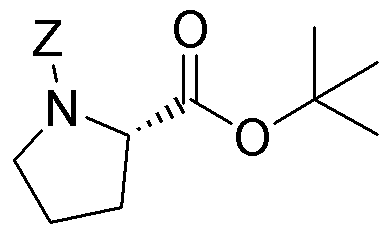Z-L-proline tert-butyl ester is widely utilized in research focused on:
- Peptide Synthesis: This compound serves as a valuable building block in the synthesis of peptides, particularly in the development of pharmaceuticals. Its unique structure allows for the formation of stable linkages, enhancing the efficiency of peptide assembly.
- Drug Development: In medicinal chemistry, it is used to create proline derivatives that can improve the bioavailability and efficacy of drug candidates, making it essential for researchers working on new therapeutic agents.
- Chiral Catalysis: The compound acts as a chiral auxiliary in asymmetric synthesis, helping chemists produce enantiomerically pure compounds. This is particularly beneficial in the production of chiral drugs, which often require high purity for effectiveness.
- Bioconjugation: It is employed in bioconjugation processes to attach biomolecules to surfaces or other molecules, facilitating the development of targeted drug delivery systems and diagnostic tools in biotechnology.
- Material Science: The compound finds applications in the development of polymers and materials, where its properties can enhance the performance and stability of the final products, making it valuable in industries such as coatings and adhesives.
General Information
Properties
Safety and Regulations
Applications
Z-L-proline tert-butyl ester is widely utilized in research focused on:
- Peptide Synthesis: This compound serves as a valuable building block in the synthesis of peptides, particularly in the development of pharmaceuticals. Its unique structure allows for the formation of stable linkages, enhancing the efficiency of peptide assembly.
- Drug Development: In medicinal chemistry, it is used to create proline derivatives that can improve the bioavailability and efficacy of drug candidates, making it essential for researchers working on new therapeutic agents.
- Chiral Catalysis: The compound acts as a chiral auxiliary in asymmetric synthesis, helping chemists produce enantiomerically pure compounds. This is particularly beneficial in the production of chiral drugs, which often require high purity for effectiveness.
- Bioconjugation: It is employed in bioconjugation processes to attach biomolecules to surfaces or other molecules, facilitating the development of targeted drug delivery systems and diagnostic tools in biotechnology.
- Material Science: The compound finds applications in the development of polymers and materials, where its properties can enhance the performance and stability of the final products, making it valuable in industries such as coatings and adhesives.
Documents
Safety Data Sheets (SDS)
The SDS provides comprehensive safety information on handling, storage, and disposal of the product.
Product Specification (PS)
The PS provides a comprehensive breakdown of the product’s properties, including chemical composition, physical state, purity, and storage requirements. It also details acceptable quality ranges and the product's intended applications.
Certificates of Analysis (COA)
Search for Certificates of Analysis (COA) by entering the products Lot Number. Lot and Batch Numbers can be found on a product’s label following the words ‘Lot’ or ‘Batch’.
*Catalog Number
*Lot Number
Certificates Of Origin (COO)
This COO confirms the country where the product was manufactured, and also details the materials and components used in it and whether it is derived from natural, synthetic, or other specific sources. This certificate may be required for customs, trade, and regulatory compliance.
*Catalog Number
*Lot Number
Safety Data Sheets (SDS)
The SDS provides comprehensive safety information on handling, storage, and disposal of the product.
DownloadProduct Specification (PS)
The PS provides a comprehensive breakdown of the product’s properties, including chemical composition, physical state, purity, and storage requirements. It also details acceptable quality ranges and the product's intended applications.
DownloadCertificates of Analysis (COA)
Search for Certificates of Analysis (COA) by entering the products Lot Number. Lot and Batch Numbers can be found on a product’s label following the words ‘Lot’ or ‘Batch’.
*Catalog Number
*Lot Number
Certificates Of Origin (COO)
This COO confirms the country where the product was manufactured, and also details the materials and components used in it and whether it is derived from natural, synthetic, or other specific sources. This certificate may be required for customs, trade, and regulatory compliance.


